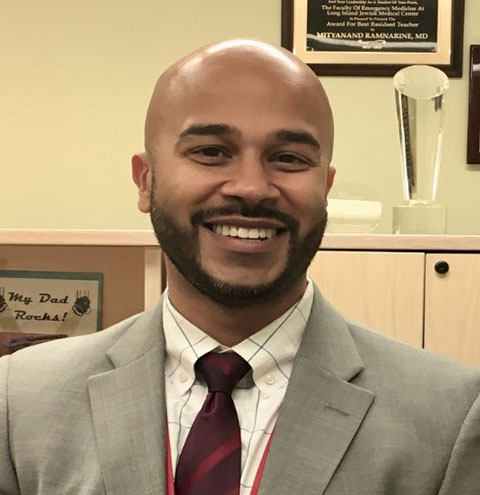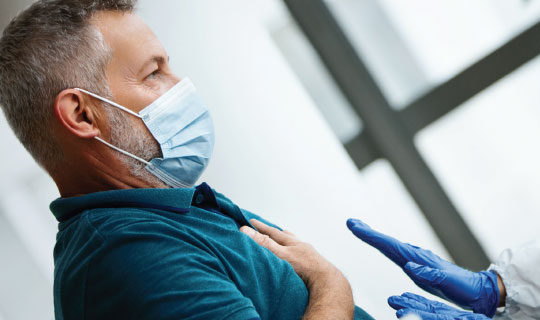Remedies range from a period of rest to creating an emergency airway opening.
When the middle-aged man arrived at the Emergency Department (ED) at Robert Wood Johnson University Hospital (RWJUH) Rahway, he couldn’t get more than one word out. It was clear to Lauren Trattner, DO, Associate Chair of the Department of Emergency Medicine, that he was laboring to breathe.

“He was leaning forward, using his abdominal muscles to breathe and making a sound known as stridor — a high-pitched, whistling sound,” she says. “It’s similar to the squeak made by a balloon when the neck is pulled tight and you allow tiny amounts of air to escape.”
This was cause for particular concern. “Stridor is an indication of a tightening somewhere along the airway,” she says. “It may mean imminent airway loss and needs to be treated immediately.”
Dr. Trattner would soon be called on to perform a cricothyrotomy, a rare emergency procedure used when an opening must be created in the neck to establish an airway.
Search for a Cause
From the patient’s family members and medical records, Dr. Trattner learned that he had recently undergone thyroid surgery at another hospital. Per standard procedure, he’d been intubated—that is, a doctor had inserted a breathing tube through his mouth or nose into his airway to help him breathe throughout the surgery.
That tube had been removed after the procedure, but the patient was having trouble breathing, so he was reintubated. After 24 hours, the tube was removed yet again, and the patient was discharged from the hospital. But his breathing problems persisted, which is how he found himself in the Rahway ED.
Dr. Trattner’s initial plan was to attempt to reintubate him. Before she could start the procedure, however, his airway closed completely, making intubation impossible.
Dr. Trattner called for a scalpel to perform the cricothyrotomy. She made an incision down the middle of the patient’s neck, inserted her finger into it to feel for the trachea (the windpipe), then created a small opening in the cricothyroid membrane — a site high on the neck, where there are fewer important arteries—through which she inserted a breathing tube. There’s little doubt that the procedure saved her patient’s life. He was then sent to the ICU for recovery, where a surgeon ultimately performed a tracheotomy.
She’s still not sure what condition compromised the patient’s airway, though she later learned that his breathing difficulty passed and the tracheal tube was removed. “The cricothyrotomy opening usually heals completely in a week or two,” Dr. Trattner says. While many patients suffer no long-term effects, some do experience a change in the quality of their voice.
Strikingly, the RWJUH Rahway ED recently had to perform several other cricothyrotomies within a month’s time. “That’s highly unusual. I’ve been an attending physician for 23 years, and this was only my second one,” says Dr. Trattner.
Although most emergency physicians aren’t eager to take on the procedure — as Dr. Trattner observes, “We’re not surgeons by training” — they’re no doubt as glad as she is that the lifesaving surgery is among their arsenal of treatments.
What to Do for Shortness of Breath
Virtually everyone feels out of breath at some point. “It’s one of the most common conditions we see in the department,” says Mityanand Ramnarine, MD,, Chair of the ED at RWJUH Rahway.

Shortness of breath is expected after a period of physical exertion, but can also occur unexpectedly. Many conditions can cause severe shortness of breath, notes Dr. Ramnarine, including:
- Trauma, such as that from a car accident
- An allergic reaction
- An asthma flareup
- A lung or upper respiratory infection, such as pneumonia
- A blood clot in the lung (a pulmonary embolism)
- Food in the windpipe
- Chronic anemia
- A cardiovascular problem, including arrhythmia and heart attack
- A collapsed lung (a pneumothorax), which can happen spontaneously or as the result of an injury
- Pulmonary issues related to COVID-19
Immediate relief may be possible in some cases—for example, using an EpiPen after a severe allergic reaction, or administering the Heimlich maneuver (an abdominal thrust that expels foreign objects) on someone who is choking.
Release may also be found by a period of rest. “If someone near you is experiencing unexplained shortness of breath, get them into a position of rest, and wait for a couple of minutes to see if the problem resolves,” says Dr. Ramnarine.
If the difficulty is severe or if it persists, call 911 right away.
In the event of a breathing emergency, call 911. Find courses in cardiopulmonary resuscitation, first aid and more.
